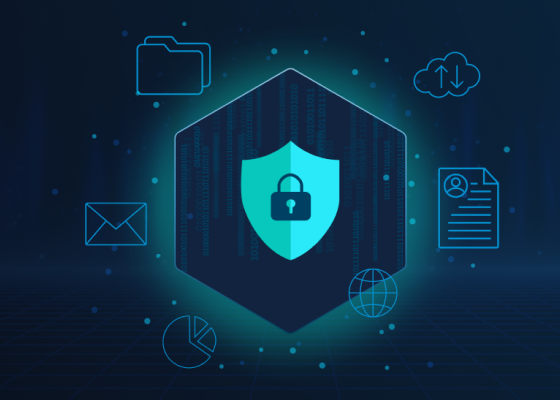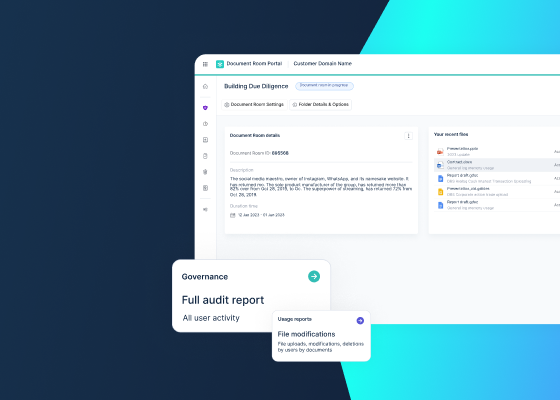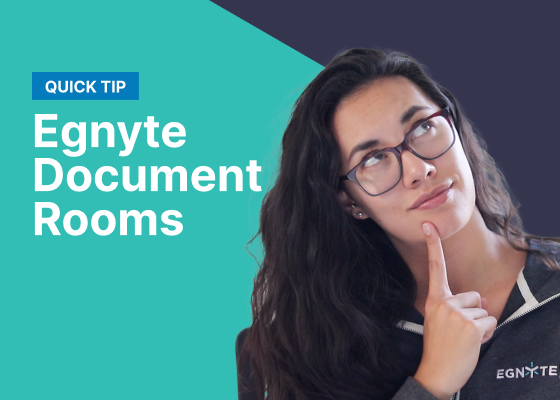A Guide to Virtual Data Room Security
This Egnyte Governance Guide outlines the general data protection capabilities available for Virtual Data Room solutions. If you’re looking for specific information about Egnyte’s Document Room solution, you can find it here. Virtual data rooms are commonly used as collaborative digital data repositories. Often, this controlled environment is used as a space where confidentiality can be preserved, and information can be easily shared. Information is accessible when required, but it is guarded to protect it from unauthorized access.
The Importance of Data Room Security
Data room security is vital, especially when using virtual data rooms. Organizations across all industries depend on the security of these virtual spaces to conduct transactions and other sensitive operations. Following are several of the reasons commonly cited for why data room security is of the utmost importance.
| What is a data room? A data room is a physical room with enhanced security systems that are used for storing and sharing confidential documents. The need for data room security is driven by the types of content stored there, such as documents related to legal and financial transactions like mergers and acquisitions. Traditional data rooms have evolved. Today, more often than not, a data room is actually a virtual data room (VDR), a digital equivalent, that provides an online space where sensitive documents are securely stored with strict authentication and access controls. Virtual data room security includes encryption and other data protection solutions that protect sensitive information while enabling authorized collaboration and sharing. |

Compliance with laws and industry regulations
Most industries are subject to various state, federal, and international laws, such as the California Consumer Privacy Act (CCPA), Health Insurance Portability and Accountability Act (HIPAA), Sarbanes-Oxley Act (SOX), and the European Union’s General Data Protection Regulation (GDPR), and industry regulations, such as Payment Card Industry Data Security Standard (PCI-DSS). Data room security facilitates compliance with these laws and regulations, helping organizations avoid strict penalties, fines, and legal actions.
Demonstrated commitment to confidentiality for partners, clients, and other stakeholders
With the preponderance of data breaches, organizations can alleviate concerns and bolster their reputation with data room security as it demonstrates a commitment to taking serious data protection measures. Using advanced data room security shows partners, clients, and other stakeholders how important it is to ensure the confidentiality of shared sensitive information.
Prevention of data leaks and cyber attacks
Data room security protects against data leaks and sophisticated cyber-attacks with advanced data protection. These include encryption, multi-factor authentication, intrusion detection systems with intrusion prevention systems (IDS/IPS), and data loss protection (DLP) systems.
Protection of confidential information
The most important function of data room security is to enable confidential and proprietary information to be protected from unauthorized access. Some types of sensitive information that require strict controls of data room security are intellectual property (e.g., related to patents, trademarks, and copyrights), financial records, legal documents, and strategic plans. Unauthorized access to that information can have significant repercussions for an organization, including:
- Giving competitors an advantage
- Legal repercussions
- Reputational damage
- Significant financial losses
Space to facilitate safe and efficient transactions
Data room security plays a crucial role in facilitating secure and confidential transactions. It provides systems and processes that confirm only authorized users can access specific documents and controls what can be done with each document to prevent sensitive data from potential compromise. The objective of data room security is to balance the need for data protection with authorized users’ need to access, share, and collaborate with sensitive information.
What Features Make Virtual Data Rooms Secure?
Virtual data room security includes multiple layers of defense to enable safe storage, sharing of, and collaboration with sensitive information. Key protections used as part of data room security are the following.
Access controls
Granular access controls are often used as part of virtual data room security to specify exactly who can do what with which documents, such as view, edit, download, and print.
Data backups
Regular data backups help facilitate data integrity and availability of critical documents, even in the event of system failures, disasters, or cyber attacks, such as ransomware attacks.
Data encryption
Advanced encryption technologies, both in transit and at rest, are a must-have for virtual data room security. These solutions encrypt data not just while it is being stored but also while being uploaded or downloaded to prevent unauthorized access or interception.
Document controls
Virtual data room security can be embedded in documents. For instance, documents can be watermarked, be made “self-destructing,” or have access restrictions. Another type of virtual data room security is secure document viewing features, such as fence views, which obstruct parts of documents, and view-only modes that prevent the downloading or printing of documents.
User authentication
To confirm that only authorized users can access sensitive information, virtual data room security includes strong user authentication mechanisms, such as multi-factor authentication (MFA). In addition to MFA, virtual data room security authentication methods can include biometrics (e.g., fingerprint, facial, or retinal scans) and time-limited access codes.
Certifications for Security and Compliance
Virtual data room providers are required to follow various security protocols to adhere to regulations. In addition, showing compliance with these regulations is often a requirement of buyers and users of a virtual data room. Several of the regulations have data protection requirements that require virtual data security are the following.
| ISO/IEC 27001 | It is a global standard for information security management systems (ISMS) that requires organizations to implement risk management processes, staff security training, conduct regular audits, and follow a continual improvement approach to data security. It is not a legal requirement but a voluntary standard that is adopted by organizations who want to enhance information security management and demonstrate credibility and trust. |
| SOC 1 and SOC 2 | These are standards that mandate rigorous data security measures, including risk assessment, access controls, data encryption, incident response plans, and regular security monitoring and auditing. It applies to service organizations, especially those managing financial, data hosting, and processing services for other entities. |
| GDPR | This law mandates strong data protection with requirements that include access control, encryption, and breach notifications. It applies to organizations within or outside the European Union that handle the personal data of individuals residing in the European Union, regardless of the organization’s location. |
| HIPAA | This law requires robust encryption, access controls, audit trails, breach notification protocols, and safeguards for storing and transmitting protected health information (PHI). It applies to covered entities in the U.S., such as healthcare providers, health plans, healthcare clearinghouses, and their business associates that handle protected health information. |
| FISMA | FISMA requires rigorous risk assessments, information system categorization, stringent security controls, continuous monitoring, and official accreditation of the security measures that are implemented. Applies to all federal agencies in the United States, their contractors, and other organizations that work with the federal government. |
| PCI-DSS | This is an industry standard that mandates secure data storage, strong access control measures, encrypted transmissions, regular security testing, and maintaining a vulnerability management program. It applies to all organizations that handle cardholder data from major credit card brands, including merchants, processors, acquirers, issuers, and service providers. |
Using Virtual Data Rooms
The uses for virtual data rooms are virtually endless. Following are several use cases that illustrate how they are commonly used and why data room security is so important.
- Clinical trials
- Fundraising
- Investor and Board of Directors communications
- IPO preparation
- Legal proceedings
- Mergers and acquisitions (M&A)
- Offer management
- Real estate transactions
- Regulatory compliance reporting
- Strategic partnerships
Apply Data Protection Best Practices to Ensure Virtual Data Room Security
Data room security, especially for virtual data rooms, is imperative. It enables sensitive data to be protected , as required by laws, regulations, and stakeholders’ expectations. Following data protection best practices, organizations can effectively protect sensitive information that is stored in virtual data rooms. In addition, many of the same technologies used to safeguard sensitive information across an organization are applied for virtual data room security.
Egnyte has experts ready to answer your questions. For more than a decade, Egnyte has helped more than 17,000+ customers with millions of users worldwide.
Last Updated: 18th April, 2024


